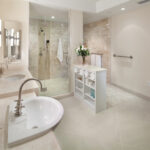Because of their longevity and classic appeal, brick surfaces have long been a popular choice for building exteriors. But as tastes and architectural styles shift, many property owners are left with worn-out, outdated brick facades that don’t match their original vision. The good news is that updating the appearance of your brick surfaces doesn’t require major renovations. Painting brick can be a revolutionary solution that revitalizes the outside of your home. We’ll examine painting brick surfaces in this blog, along with all of its advantages.
Why Would You Paint Brick Surfaces?
Prior to exploring the procedure and advantages of painting brick surfaces, it’s critical to comprehend the reasons behind property owners’ decisions:
Aesthetic Transformation: Weathering, staining, and discoloration are some of the reasons why brick surfaces can appear worn out or antiquated over time. Painting brick gives you the ability to create a modern, fresh look that goes well with your preferred style.
Customized Color: Painting brick gives you the chance to match your brand identity or personal style to the exterior color of your building. You can choose a bold and colorful shade or a subtle, neutral tone—the options are almost endless.
Protection: Painting brick surfaces has a functional use as a protective barrier, going beyond aesthetics. It protects the bricks from elements that can cause deterioration and erosion, such as moisture, high temperatures, and the elements.
Upkeep: Painting brick requires less cleaning and upkeep than bare brick. Because stains and dirt are less likely to pierce the paint, maintaining the fresh, well-kept appearance of your building will be easier.
Painting Brick Surfaces: An Overview
Painting brick surfaces is a painstaking procedure that needs to be done in multiple steps to produce a long-lasting and attractive finish. This is a summary of the normal procedure:
1. Surface Preparation: A good paint job requires careful preparation. In order to eliminate any loose mortar as well as dust, grime, and dirt, the brick surface must be thoroughly cleaned in this step. Frequently, pressure washing is employed to attain a spotless and even surface.
2. Restoration and Repair: Prior to painting, any deteriorated or damaged brickwork needs to be replaced or repaired. To maintain structural integrity, this can entail repairing chipped bricks, sealing mortar joints, and filling in cracks.
3. Primer Application: For optimal paint adhesion, a premium primer must be applied. In addition to sealing the surface, primer creates a foundation on which paint can stick. Additionally, it keeps paint from soaking too deeply into the brick.
4. Paint Selection: It’s critical to select the appropriate paint type. Because acrylic latex paint is breathable, long-lasting, and moisture-resistant, it is frequently used to paint brick surfaces. Additionally, there are specialty masonry paints made for brick surfaces.
5. Painting: The actual painting procedure entails painting the brick surfaces with the selected paint. To guarantee an even and consistent coat, it’s critical to use the right tools, such as paint rollers and brushes. It might take several coats to get the coverage and color you want.
6. Final Touches: After the paint has been applied and allowed to dry, the final touches can be added. In order to improve the overall visual appeal, this could involve trim work, accent colors, or decorative details.
Paint-Brick Surface Advantages
After discussing the procedure, let’s look at the many advantages of painting brick surfaces:
1. Aesthetic Transformation: Painting brick offers an aesthetic transformation that is the most obvious advantage. You can make aesthetic updates to your property to create a unified style that complements your taste in design or the newest architectural fads.
2. Color Customization: You can paint brick surfaces in a variety of colors to get the exact appearance you want. You can choose the exterior color of your property to match the classic white or a bold and contemporary shade.
3. Protection from the Elements: Moisture, high temperatures, and pollutants can harm brick surfaces. Bricks that have been painted offer a barrier of defense against these factors, extending their lifespan and requiring less upkeep.
4. Better Insulation: Paints intended for brick surfaces sometimes have insulating qualities. This may lower your building’s heating and cooling expenses by assisting in temperature regulation.
5. Enhanced Curb Appeal: The curb appeal of your home can be greatly increased with a well-painted brick exterior. It can raise the market value of your building by enhancing its appeal to prospective tenants or buyers.
6. Easier Maintenance: Compared to bare brick, painted brick surfaces require less cleaning and upkeep. The paint is less likely to absorb stains and dirt, which simplifies routine maintenance.
7. Hide Imperfections: Painting can successfully cover up imperfections in your brick surfaces, such as stains, discoloration, or uneven coloring, giving the appearance of a flawless property.
8. Preserving Historic Buildings: Painting may be an option for historic structures whose brickwork is deteriorating. It offers a modernized appearance that honors the building’s history while also aiding in the preservation of the original brick.
9. Increased Durability: Premium paints are made to withstand weather and fade resistance when applied to brick painting projects. Your investment in a professional painting company for painting brick surfaces will last for many years thanks to its durability.
10. Cost-Effective Update: Painting brick surfaces is an affordable way to update the look of your property, as opposed to major renovations or cladding materials. It provides a substantial change for a much lower price.
Points to Consider Prior to Painting Brick Surfaces
Although painting brick surfaces has many advantages, there are a few key things to remember:
1. Permeability: Brick surfaces naturally release moisture and can breathe thanks to their porous nature. It’s critical to use breathable paint products when painting brick so that moisture isn’t trapped and cause structural problems.
2. Maintenance: Although painted brick requires less cleaning and upkeep than bare brick, it still needs to be done occasionally. To preserve the look and protective qualities, you might need to repaint every five to ten years, depending on variables like exposure and climate.
3. Historic Preservation: Before painting brick, make sure your property complies with all applicable local laws and preservation guidelines if it is historically significant. There may be limitations on changing the exterior of historic buildings in some historic districts.
4. Color Selection: Give your brick surfaces some serious thought when choosing their color. Take into account your long-term design preferences, the surrounding area, and the architectural style of your property.
In Summary
Painting brick surfaces can be a game-changer when it comes to modernizing the look and preserving the external durability of your home. Numerous advantages are provided by it, including increased durability and weather resistance as well as aesthetic customization. Painting brick surfaces is a flexible and affordable solution that can revitalize the outside of your property, whether you’re looking to update the look of your dilapidated brick facade or maintain the character of a historic building. If you’re considering a brick painting project, don’t hesitate to contact us for professional assistance and expert guidance.





